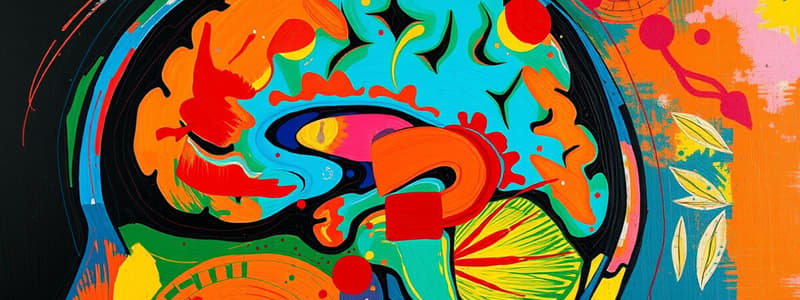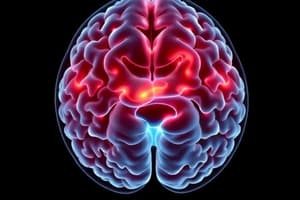Podcast
Questions and Answers
What is a common clinical manifestation of intracerebral hemorrhage?
What is a common clinical manifestation of intracerebral hemorrhage?
- Increased appetite
- Persistent dizziness
- Sudden onset of severe headache and vomiting (correct)
- Gradual onset of mild headache
What can influence the extent of focal neurologic deficits in cases of intracerebral hemorrhage?
What can influence the extent of focal neurologic deficits in cases of intracerebral hemorrhage?
- Location and extent of the bleeding (correct)
- Age of the individual
- Presence of a headache
- Time of day the injury occurred
Which of the following is NOT a type of seizure?
Which of the following is NOT a type of seizure?
- Partial or focal
- Absence
- Tonic-clonic
- Chronic (correct)
What characterizes a seizure disorder?
What characterizes a seizure disorder?
Which of the following could be a secondary cause of seizures?
Which of the following could be a secondary cause of seizures?
In cases of status epilepticus, what occurs?
In cases of status epilepticus, what occurs?
Which type of seizure is typically seen in children and induced by fever?
Which type of seizure is typically seen in children and induced by fever?
What may happen to an individual's clinical status in cases of intracerebral hemorrhage?
What may happen to an individual's clinical status in cases of intracerebral hemorrhage?
What condition is characterized by the complete clearance of neurologic deficits within 24 hours?
What condition is characterized by the complete clearance of neurologic deficits within 24 hours?
What is the likely outcome without definitive diagnosis and treatment within a year for individuals who experience ischemic symptoms?
What is the likely outcome without definitive diagnosis and treatment within a year for individuals who experience ischemic symptoms?
What is referred to as 'stroke-in-evolution'?
What is referred to as 'stroke-in-evolution'?
What primarily causes an embolic stroke?
What primarily causes an embolic stroke?
What happens if persistent vessel obstruction is not resolved rapidly?
What happens if persistent vessel obstruction is not resolved rapidly?
Which artery is most commonly associated with embolic strokes?
Which artery is most commonly associated with embolic strokes?
What is a defining characteristic of unstable plaque as compared to stable plaque?
What is a defining characteristic of unstable plaque as compared to stable plaque?
What symptom might an individual with ischemic changes experience?
What symptom might an individual with ischemic changes experience?
What is a common risk factor for cardio-embolic stroke?
What is a common risk factor for cardio-embolic stroke?
Which condition is primarily associated with decreased motor ability on the affected side after a stroke?
Which condition is primarily associated with decreased motor ability on the affected side after a stroke?
What does the F.A.S.T. test acronym stand for in detecting stroke symptoms?
What does the F.A.S.T. test acronym stand for in detecting stroke symptoms?
Which of the following symptoms may occur as a result of subsequent cerebral edema after a stroke?
Which of the following symptoms may occur as a result of subsequent cerebral edema after a stroke?
What is the typical outcome of valvular heart disease concerning stroke prevention?
What is the typical outcome of valvular heart disease concerning stroke prevention?
What can result from damage to the brain regions responsible for language processing?
What can result from damage to the brain regions responsible for language processing?
How does the artery obstructed affect clinical manifestations of thrombotic stroke?
How does the artery obstructed affect clinical manifestations of thrombotic stroke?
What is a severe consequence of untreated cerebral edema following a stroke?
What is a severe consequence of untreated cerebral edema following a stroke?
What characterizes a generalized seizure?
What characterizes a generalized seizure?
What is a common feature of tonic-clonic seizures?
What is a common feature of tonic-clonic seizures?
What happens during the postictal state following a generalized seizure?
What happens during the postictal state following a generalized seizure?
How long do most seizures typically last?
How long do most seizures typically last?
Which phase is associated with the clonic aspect of a tonic-clonic seizure?
Which phase is associated with the clonic aspect of a tonic-clonic seizure?
What can trigger a generalized seizure in some patients?
What can trigger a generalized seizure in some patients?
Which of the following is considered a medical emergency in seizure management?
Which of the following is considered a medical emergency in seizure management?
What is NOT a characteristic of generalized seizures?
What is NOT a characteristic of generalized seizures?
What is a primary clinical manifestation of Alzheimer's disease?
What is a primary clinical manifestation of Alzheimer's disease?
Which neurotransmitter is most significantly affected in Alzheimer's disease?
Which neurotransmitter is most significantly affected in Alzheimer's disease?
Which of the following functions is eventually impacted by Alzheimer's disease?
Which of the following functions is eventually impacted by Alzheimer's disease?
What is noted as one of the emotional responses in patients with Alzheimer's disease?
What is noted as one of the emotional responses in patients with Alzheimer's disease?
What is the nature of the memory loss associated with Alzheimer's disease?
What is the nature of the memory loss associated with Alzheimer's disease?
What is currently known about the cause of Alzheimer's disease?
What is currently known about the cause of Alzheimer's disease?
Flashcards are hidden until you start studying
Study Notes
Ischemic Stroke
- Transient Ischemic Attack (TIA) causes temporary neurologic deficits, including vision changes, speech issues, motor dysfunction, and dizziness, resolving within 24 hours.
- Without diagnosis and treatment, 80% of individuals experience recurrence of symptoms within one year, with many advancing to complete stroke.
Types of Stroke
- Cerebral Thrombosis: Stable plaque leads to narrowing or occlusion, resulting in progressive neurologic dysfunction termed "stroke-in-evolution." Without rapid restoration of perfusion, cerebral infarction leads to a completed stroke.
- Embolic Stroke: Caused by fragments from thrombus outside the brain (heart, aorta), often affecting the middle cerebral artery and leading to occlusion and complete stroke.
Risk Factors for Cardio-embolic Stroke
- Atrial fibrillation, myocardial infarction, and valvular heart disease increase the risk.
- Individuals typically receive anticoagulation therapy (e.g., warfarin) to prevent complications, including stroke.
Clinical Manifestations of Thrombotic Stroke
- Symptoms vary based on the afflicted artery, with common issues arising from middle cerebral artery obstruction including:
- Hemiparesis or hemiplegia (weakness or paralysis on one side)
- Hemisensory loss (diminished sensation on one side)
- Aphasia; potential complications include decreased consciousness, brain herniation, or death due to cerebral edema.
Aphasia and Stroke Recognition
- Aphasia occurs due to brain damage affecting language comprehension and production.
- F.A.S.T. test helps identify stroke symptoms:
- Face: Check for drooping
- Arms: See if one arm drifts down
- Speech: Assess clarity
Intracerebral Hemorrhage
- Characterized by sudden severe headache and vomiting.
- Loss of consciousness and coma may occur; neurologic deficits depend on bleeding extent and location.
- Deterioration of clinical status can happen rapidly despite intervention.
Seizure Disorders
- Involves recurrent abnormal electrical impulses in the brain, categorized into:
- Generalized Seizures: Spread rapidly throughout both hemispheres, causing loss of consciousness.
- Types include tonic-clonic (grand mal), absence (petit mal), and febrile seizures.
- Partial Seizures: Can be simple or complex, localized to one area.
- Generalized Seizures: Spread rapidly throughout both hemispheres, causing loss of consciousness.
Generalized Seizures
- Tonic-clonic seizures include dramatic muscle contractions and postictal confusion.
- Most seizures last 30 seconds to 2 minutes; seizures over five minutes are a medical emergency.
Alzheimer’s Disease
- Characterized by progressive memory loss, particularly for recent events, alongside emotional disturbances.
- Progressive decline in cholinergic neurons leads to further cognitive impairments, including impact on judgment and abstract thinking.
Studying That Suits You
Use AI to generate personalized quizzes and flashcards to suit your learning preferences.




